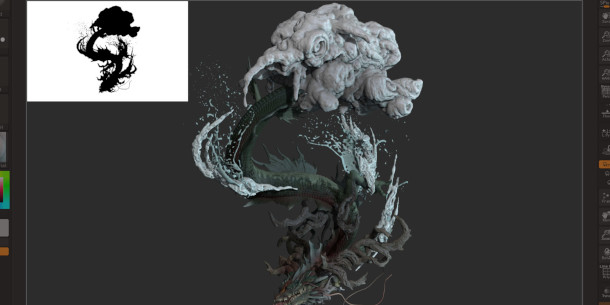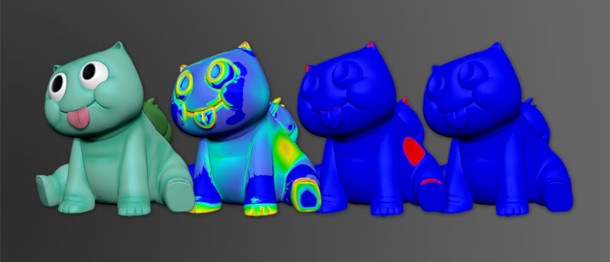Pixologic ships ZBrush 2020
Originally posted on 6 November 2019. Scroll down for news of the commercial release.
Pixologic has unveiled ZBrush 2020, the next major update to its digital sculpting software.
The release adds a set of interesting new history-aware sculpting tools, the option to sculpt or paint on the UV unfolded surface of a model, and to edit the colours of previously Polypainted assets.
Artists creating models for 3D printing get a new real-time draft analysis system, automatic analysis of the wall thickness required to fabricate a model, and improved file export options.
The update – which, yet again, is free to all existing ZBrush users – is currently available to pre-order, and will ship on 12 November 2019.
Use the new HistoryRecall brush to selectively undo or redo changes to a sculpt
Most of the tools in ZBrush 2020 were previewed at Pixologic’s ZBrush Summit user event earlier this year, so check out our original story for more details.
Of the new features, perhaps the most unusual are the new history-aware sculpting tools, like the HistoryRecall brush shown in the video at the top of the story.
Users can select the state of a model from the Undo timeline, then paint that state over the model in its current form, selectively reversing any changes made.
The workflow can also be used in reverse, projecting Redo History over the model in an earlier state.
The system is topology-independent, so it works regardless of any changes that have been made to the model in between; or even to transfer detail from one model to another.
New XTractor brushes paint local changes in surface detail across a sculpt
The three new XTractor brushes work in a similar way, but on a smaller scale, with the user sweeping the brush across part of the surface of a model to capture surface details that have changed.
The details recorded can then be painted back over new areas of the sculpt.
New Infinite Depth option for sculpting brushes
There are also a couple of modelling features that weren’t shown in the ZBrush Summit demo, including a new Infinite Depth option for several of the existing brushes.
Pixologic describes the feature as “adding detail to anything that is directly inline with the brush cursor”.
Another way to put it might be that Infinite Depth makes it possible to modify geometry equally at any point along a line of influence, rather than only those parts of the model nearest the viewer.
As a practical example, Pixologic suggests that the system could be used to make identical changes to the front and hind legs of a creature sculpt simultaneously.
Other modelling features: sculpt only on forward strokes
Another interesting change is the option to set a brush only to apply details on forward movements.
Pixologic says that the setting can be combined with the Backtrack option in LazyMouse to apply strokes of the exact same length over one another without having to lift the stylus.
Other new sculpting resources include ZeeZoo, originally titled ‘Z Zoo’ in the ZBrush Summit presentation: a set of readymade ZSphere armatures intended to provide a head start when modelling creatures.
In addition, the existing 2.5D DecoBrush is now a true 3D tool.
Morph UV system makes it possible to paint or sculpt on a UV unfolded surface
Another major workflow improvement is Morph UV, which enables users to UV unfold the SubTool selected, then sculpt or paint directly on the flattened surface.
Use cases suggested by Pixologic include making long continuous strokes across the surface of complex models: for example, when sculpting the seams on clothing.
The feature also prevents distortion when projecting a texture onto the model using SpotLight.
Other texturing changes in ZBrush 2020 include Texture Adjust by Color and Polypaint Adjust by Color, which make it possible to selectively edit texture maps or Polypaint colours applied to a model.
Users can use colour picking to mask parts of the model before adjusting hue, saturation and contrast, making it possible to preserve smooth colour gradients in the edited asset.

New ViewCube-like CamView system and real-time silhouette display
More general changes include CamView, Pixologic’s equivalent to the ViewCube in Autodesk software.
The new 3D widget displays a model’s orientation relative to the world axis, and can be used to rotate, or toggle between top, bottom, left and right views.
However, unlike the ViewCube, the widget is customisable, so you can use your own model instead of the default camera.
There is also a self-explanatory new Real-Time Silhouette view, shown above, which can be toggled to check the silhouette of a model while sculpting to ensure that it ‘reads’ correctly against a background.
Automated draft analysis and wall thickness analysis systems for 3D printing
Artists creating models for manufacturing get a new real-time draft analysis system.
As with the equivalent tools in CAD software, it is designed to identify and troubleshoot parts of a model that will cause problems during injection moulding where, in order for the cast to pull away cleanly from the mould, its sides must be angled slightly, not parallel to the pull direction, or undercutting it.
Once the pull direction has been set, ZBrush displays a coloured overlay on the model, showing parts that will separate cleanly in green, and problem areas in yellow or red.
The display updates in real time, so an artist can continue sculpting or making parametric changes to the model until all of the problem areas are resolved, and everything goes green.

The new Wall Thickness feature takes a similar approach, using Polypaint colours to indicate areas of a model that need to be adjusted before printing or CNC machining.
The colour overlay is based on the minimum and maximum wall thickness values specified by the user.
In addition, ZBrush 2020 can now display a model’s bounding box size, mesh volume and surface area with a single click, to help estimate the volume of materials needed for fabrication.
There is also a new Import/Export Options window, which supports a range of common 3D printing file formats – OBJ, FBX, STL, PLY and VRML – rather than exporting via the 3D Print Hub and FBX Export plugins.
Updated 12 November 2019: ZBrush 2020 is now shipping. Pixologic has posted demo videos of most of the key features on its YouTube channel.
Pricing and system requirements
ZBrush 2020 is available for 64-bit Windows Vista and above and Mac OS X 10.10 and above. The update is free to all registered users.
New perpetual licences cost $895 and subscriptions cost $39.95/month or $179.95 for six months. At the time of posting, all are available at a ZBrush 2020 launch discount.
Read an overview of the new features in ZBrush 2020 on Pixologic’s website
